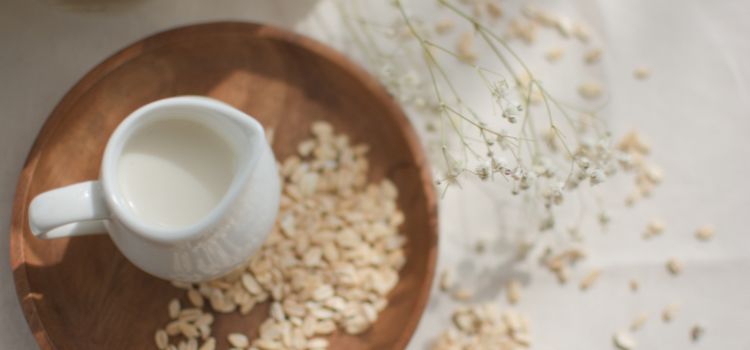As an Amazon Associate, I earn from qualifying purchases

In recent years, oat milk has taken the world by storm, becoming a beloved alternative to dairy milk. Its rise in popularity is due to a combination of factors: the demand for plant-based milk alternatives, its creamy texture, and a growing awareness of environmental benefits associated with oat production.
Unlike some other plant-based milks, oat milk boasts a natural sweetness and a rich consistency that closely mimics cow’s milk, making it an ideal choice for coffee enthusiasts.
Frothing is a process that transforms milk into a silky microfoam, enhancing both the texture and flavor of coffee drinks. When milk is frothed, air is incorporated into it, creating bubbles that result in a creamy foam.
This foam is essential in creating the luxurious feel of lattes, cappuccinos, and other specialty coffee beverages. The science behind frothing lies in the milk proteins’ ability to encapsulate air, forming stable bubbles that contribute to the drink’s allure.
Can Oat Milk Be Frothed? A Creamy Comparison
So, can oat milk be frothed like its dairy counterpart? The short answer is yes, but with a few caveats. Oat milk’s frothing capabilities largely depend on its formulation. Unlike cow’s milk, which naturally contains the proteins and fats necessary for frothing, oat milk may require some assistance. Many brands offer “barista blend” oat milk, specifically designed to froth well, thanks to added oils and proteins.
Comparing oat milk to dairy milk, the froth of oat milk tends to be lighter and less dense. However, with the right techniques and a bit of practice, you can achieve a beautiful foam that complements coffee perfectly. Factors such as protein content and additives like oil or emulsifiers enhance frothing capabilities, making certain oat milks more suitable for frothing than others.
A Step-by-Step Guide to Frothing Oat Milk at Home

Frothing oat milk at home is an art anyone can master with the right tools and techniques. Here’s a simple guide to get you started:
- Equipment: Invest in a good-quality milk frother, steam wand, or handheld frother. Each tool offers different benefits, with steam wands typically producing the finest foam.
- Preparation: Start with cold oat milk. Cold milk froths better and gives you more control over the frothing process.
- Frothing Techniques: Pour the oat milk into your frothing pitcher, filling it no more than a third full to allow room for expansion. If using a steam wand, position the wand just below the surface of the milk to introduce air. Gradually lower the wand deeper as the milk expands, maintaining a slight angle to create a whirlpool effect.
- Consistency: Continue steaming until the milk reaches your desired temperature and consistency, typically around 150°F. The milk should double in volume and form a velvety microfoam.
- Final Touch: Tap the pitcher gently on a counter and swirl the milk to remove any large bubbles, achieving a smooth texture.
Tips for Achieving the Best Froth
- Choose the Right Oat Milk: Opt for barista blends, which are formulated to froth better. If unavailable, experiment with different brands to find one that suits your taste.
- Optimal Temperature and Volume: Froth at a moderate volume and temperature to avoid scalding the milk, which can ruin the texture.
- Common Mistakes: Avoid overheating and over-frothing, as these can lead to a burnt taste and a frothy mess. Practice makes perfect, so don’t be discouraged by initial setbacks.
Conclusion
Frothing oat milk offers a delightful way to enhance your coffee creations, bringing a creamy texture that’s both satisfying and environmentally friendly. While oat milk may present some challenges compared to traditional dairy, with a bit of experimentation and patience, you can master the art of frothing.
This journey into oat milk froth opens up a world of possibilities for coffee lovers eager to explore plant-based options. So grab your frother, embrace the challenge, and enjoy crafting your perfect oat milk latte at home!
FAQ
How do you make oat milk frothy?
To make oat milk frothy, start by selecting a barista blend oat milk, as it is formulated to froth better. Use a milk frother, steam wand, or handheld frother. Begin with cold oat milk, filling your frothing pitcher no more than a third full. If using a steam wand, position it just below the surface of the milk to introduce air, then gradually lower it to create a whirlpool effect. Continue steaming until the milk reaches about 150°F, forming a velvety microfoam. Tap the pitcher gently on the counter and swirl to eliminate large bubbles for a smooth texture.
Why can’t I froth oat milk?
If you’re having trouble frothing oat milk, it might be due to the type of oat milk you’re using. Regular oat milk may lack the necessary proteins and fats needed for frothing. Try switching to a barista blend, which is specifically designed to froth. Also, ensure your milk frother or steam wand technique is correct. Avoid overheating or over-frothing, which can result in poor texture. Practice makes perfect, so experiment with different oat milk brands and frothing methods.
Can you cold foam oat milk?
Yes, you can cold foam oat milk! Cold foaming involves frothing milk without heating it, typically using a handheld frother or a milk frother with a cold foam setting. Start with cold oat milk, preferably a barista blend, and froth until you achieve a light, airy foam. Cold foam is a great addition to iced coffee drinks, adding a creamy texture without altering the temperature of your beverage.
As an Amazon Associate, I earn from qualifying purchases